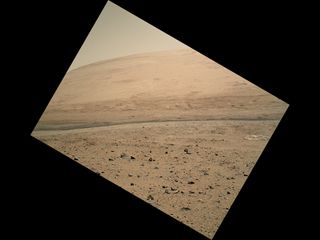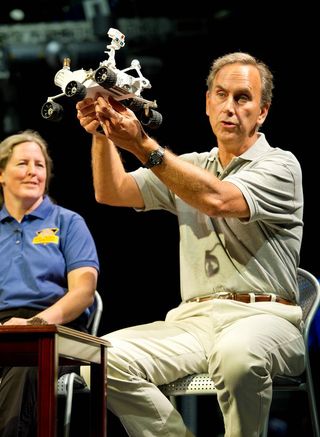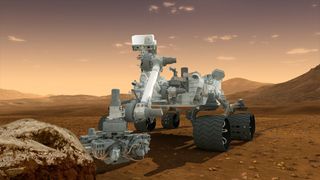
One year ago Monday (Aug. 5), NASA's Mars rover Curiosity pulled off a stunning and unprecedented landing inside Gale Crater, kicking off a two-year surface mission to determine if the Red Planet could ever have supported microbial life.
The 1-ton rover has already achieved that goal, finding that a site called Yellowknife Bay was indeed habitable billions of years ago. Curiosity is now motoring toward its main science destination, the foothills of the huge and mysterious Mount Sharp.
SPACE.com caught up last week with Curiosity chief scientist John Grotzinger, a geologist at the California Institute of Technology in Pasadena, to discuss the mission's highlights so far, what Curiosity may discover in the future and why the rover didn't set out for Mount Sharp right away. [Curiosity's First Year on Mars in Two Minutes (Video)]
SPACE.com: Does it seem like it's been a full year since all of the drama and excitement of landing night?
John Grotzinger:Not at all — looking back on it, I just cannot believe it's been a year.
SPACE.com: So how are you and the team feeling now?
Grotzinger: We're feeling great; the whole team is really excited. The time has gone by quickly, but we're amazed at how much we were actually able to accomplish. And there's two reasons for that. One is that Curiosity has basically performed flawlessly, in terms of the science measurements we wanted to get. And the other one is that the geology really worked out well. The decision to drive in the opposite direction and then hunker down for a couple of months there in retrospect turns out to be a really good one.
Get the Space.com Newsletter
Breaking space news, the latest updates on rocket launches, skywatching events and more!
And there the team gets great credit for having done the mapping in advance, before we landed. There was some risk involved in that, but in the end it worked out great. So it's been terrific, and we just hope the rest of the mission now, as we get to Mount Sharp and all those layers there, that they provide some more really exciting stuff.
SPACE.com: Was it a tough decision not to go to Mount Sharp right away? Because you never know how long you have on Mars with everything working well.
Grotzinger: There was a very strong consensus [to go to the Yellowknife Bay area first], for two reasons. One is, it wasn't that far away. That was a big factor. Basically, as the crow flies it was 600 meters to the bottom of Yellowknife Bay.

The other reason was that, as we told everybody in advance of landing, there was that high thermal inertia unit there. And that was kind of a beacon. We didn't fully understand what it meant, but the mapping showed that the rocks with that property were downslope of the obvious expression of the alluvial fan.
All of the mapping pointed to this basically being sedimentary rocks, and I think the team ingested that quite well, and we went down there and held our breath. The APXS [Alpha Particle X-ray Spectrometer instrument] data basically showed average composition basaltic Mars.
So as we analyzed the sheetbed mudstone before we drilled it, we still had some fear. Even though it really didn't look like a lava flow, you just don't know — it's Mars. So when those CheMin [Chemistry and Mineralogy instrument] results came back and we saw the rock was not just composed of a few percent clay, but 15 to 20 percent clay [an indication of extensive past exposure to liquid water], that was big for us.
If you ask me what the top three results were for the mission, that is certainly one of them. The day when we got those data back, everybody was jumping up and down and the rest is kind of history now.
SPACE.com: So that was one of the top three discoveries in Curiosity's first year. What were the other two?
Grotzinger: They sort of went in sequential order. The first was the conglomerate. We had made the decision to drive. Of course we're nervous about that decision; we're hoping it's going to be the right one. And when we got the conglomerate, it was a real shot in the arm that we were on the right path, and we kind of had the scent of the trail. [Curiosity's 7 Biggest Achievements (So Far)]
And of course at the same time, it told us that for years what we looked at from orbit — these things that we thought were alluvial fans are alluvial fans. So the leverage that you get globally in terms of your understanding of Mars — that's a big result for us.
And then I would say after that it was the confirmation from CheMin that we had the clays there. Because in one fell swoop, we're able to confirm that the orbiters that have been predicting clays on Mars — there are in fact clays on Mars, and it also tells us that this rock is seriously altered.
The third thing was basically demonstrating that the sheetbed mudstone represented a habitable environment. That conclusion did not come from one instrument, but from pretty much every instrument on the spacecraft. The reason the spacecraft was built was for a moment like this.
SPACE.com: You guys achieved Curiosity's main goal with that third discovery. So what does the mission team hope to accomplish now?
Grotzinger: Now we really get to have all the fun. I mean, we've been having a lot of fun, but now the pressure's off and we can raise the bar.
Now what we can do is go to Mount Sharp and look at those layers, just like we had always planned to do. We hope to arrive at the base of Mount Sharp and get stuck into that part of the mission probably near the end of our nominal mission of two years.
It's going to take a while to get there. I can't tell you exactly where, but we're going to stop along the way and make measurements, because what we want to try to do is tie in the stratigraphy that we measured at Yellowknife Bay — that 5 meters or so of rocks that we studied there, tie those into the rocks that we see at the base of Mount Sharp. [Curiosity on the Road to Mount Sharp (Video)]
At the end of the mission, we want to be able to look back and say, "OK, we found clays at Yellowknife Bay and we found clays at Mount Sharp. Is that the same unit?" That will be important someday.
And finally, I'll add that we really want to pursue this business of organics on Mars. Looking for organics on Earth is a tough thing to do. But these things have rulebooks, and there are conceptual formulae for certain environmental conditions that were friendlier for preservation of organics.
Hopefully, by the end of our mission we're going to have investigated what could be — well, we know we got at least one and we're hoping to get more, maybe two, three, four different kinds of what might have been a habitable environment. And the question is, which one of those might be better for preserving organics? If we find organics in one of those scenarios versus the other, then we're going to have a good paradigm to pass forward to future missions.
SPACE.com: Are you still hoping to climb about 800 meters up Mount Sharp — high enough to study the transition zone between wetter early Mars and dry modern Mars?
Grotzinger: Yeah. We hope that we'll be able to drive long enough and high enough to be able to cross that boundary — that'll be a really key one for us. I think that this many-hundred-meter climb through the foothills of Mount Sharp could be just a great story in understanding the early environmental evolution of Mars.
SPACE.com: And I imagine the views from up there would be pretty amazing, if you're able to climb that high.
Grotzinger: Yeah — it'll be great outreach, I'm sure. The view out across the valley will be interesting, but what I'm really looking forward to is the scenery that we drive through. It's going to seem close; it'll feel intimate, I think, and very Earthlike as we drive through these buttes and mesas, like being out in the Four Corners area [of the southwestern United States].
SPACE.com: How do you feel about what Curiosity's mission has done so far to help other NASA Mars missions, such as the rover the space agency plans to launch in 2020?
Grotzinger: The success of EDL [entry, descent and landing] was obviously very important. I have no reason to believe that it won't go just as successfully in 2020.
After that point, I think what we're learning to do — landing at Gale, and having chosen Gale as a landing site — what that shows is that the Mars program is really working, in the sense that I think the days are over, hopefully, of landing and getting snakebit that what you landed on is something totally different from what you thought you were going to see from orbit.
With the success of HiRise, the success of CRISM — those instruments [aboard NASA's Mars Reconnaissance Orbiter] work so well that we were able to make these detailed maps, and when we landed, we had really good hypotheses in place. So I would think for 2020, our success will pass forward to encourage them to do the same kind of mapping in advance.
And then I think the way that you go about doing something like exploring for habitable environments and exploring for organic carbon — whatever we learn from this mission will help develop that recipe book to most expeditiously drive a rover in the future. [The Boldest Mars Missions in History]

SPACE.com: How do you feel about Curiosity's role in advancing the Mars program more broadly, by generating interest in exploration of the Red Planet?
Grotzinger: Obviously, we feel really good about it all. We're all grateful for having had the chance to participate in this key mission. And as you know, it was kind of a swinger — it could have gone either way, and to be successful gives you a great sense of accomplishment.
It just underscores the importance and the value of NASA's Mars program. This was not an accident, that all this good stuff happened. It was being prepared, and it was slotting this mission into the playbook of the NASA Mars program, and if we looked farther, as trite as it sounds, it's because we stood on the shoulders of giants. The rover missions that came before us and the orbiter missions, and that synergy between the surface missions and the orbiter missions — it just demonstrates how well that works.
Follow Mike Wall on Twitter @michaeldwall and Google+. Follow us @Spacedotcom, Facebook or Google+. Originally published on SPACE.com.
Join our Space Forums to keep talking space on the latest missions, night sky and more! And if you have a news tip, correction or comment, let us know at: community@space.com.

Michael Wall is a Senior Space Writer with Space.com and joined the team in 2010. He primarily covers exoplanets, spaceflight and military space, but has been known to dabble in the space art beat. His book about the search for alien life, "Out There," was published on Nov. 13, 2018. Before becoming a science writer, Michael worked as a herpetologist and wildlife biologist. He has a Ph.D. in evolutionary biology from the University of Sydney, Australia, a bachelor's degree from the University of Arizona, and a graduate certificate in science writing from the University of California, Santa Cruz. To find out what his latest project is, you can follow Michael on Twitter.
